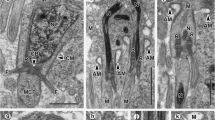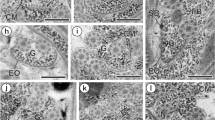Abstract
Spermatogenesis, testes, and vas deferens in the parthenogenetic monozoic tapeworm Atractolytocestus huronensis Anthony, 1958 (Cestoda: Caryophyllidea) from Slovakia, parasitizing the carp Cyprinus carpio L., have been investigated by means of transmission electron microscopy for the first time. The present results show that helminths with parthenogenetic and normal reproduction may share some common spermatology features, e.g., dense cytoplasm of the peripherally localized spermatogonia or a rosette type of spermatogenesis. In contrast to tapeworms with normal reproduction, the most prominent ultrastructural characteristic of the spermatocytes of A. huronensis is fragmentation of their nuclei. This clear feature of cell degeneration might be a consequence of the aberrant first meiotic division. Peripheral cortical microtubules and a single centriole, indicators of the ongoing spermiogenesis, were observed only very rarely in the early spermatids. Characteristics of normal spermiogenesis, i.e., apical dense material in the zone of differentiation in early stages of spermiogenesis, flagellar rotation, and proximo-distal fusion, were never found in the present study. The testes follicles are surrounded by a thin cytoplasmic sheath underlined by a basal lamina. Vas deferens is lined by flat epithelium with numerous surface lamellae and cilia. Mature, functional spermatozoa were not observed in the vas deferens of A. huronensis from Slovakia.



Similar content being viewed by others
References
Bruňanská M (2009) Spermatological characters of the caryophyllidean cestode Khawia sinensis Hsü, 1935, a carp parasite. Parasitol Res 105:1603–1610
Bruňanská M (2010) Recent insights into spermatozoa development and ultrastructure in the Eucestoda. In: Lejeune T, Delvaux P (eds) Human spermatozoa: maturation, capacitation and abnormalities. Nova Science, New York, pp 327–354
Bruňanská M, Poddubnaya LG, Dezfuli B (2005) Vitellogenesis in two spathebothriidean cestodes. Parasitol Res 96:390–397
Bruňanská M, Drobníková P, Oros M (2009) Vitellogenesis in the cestode Atractolytocestus huronensis Anthony, 1958 (Caryophyllidea: Lytocestidae). Parasitol Res 105:647–654
Cable RM (1971) Parthenogenesis in parasitic helminths. Am Zool 11:267–272
Cannon LRG (1971) The life cycle of Bunodera sacculata and B. luciopercae (Trematoda: Allocreadiidae) in Algonquin Park, Ontario. Can J Zool 49:1417–1429
Davydov VG, Poddubnaya LG, Kolesnikova GA (1994) Ultrastructure of genital system ducts of Caryophyllaeus laticeps (Cestoda, Caryophyllidea). Parazitologiya 28:501–509, In Russian
Dobson MJ, Pearlman RE, Karaiskakis A, Spyropoulous B, Moens PB (1994) Synaptonemal complex proteins: occurrence, epitope mapping and chromosome disjunction. J Cell Sci 107:2749–2760
Fujino T, Ishii Y (1982) Ultrastructural studies on spermatogenesis in a parthenogenetic type of Paragonimus westermani (Kerbert 1878) proposed as P. pulmonalis (Baelz 1880). J Parasitol 68:433–441
Grey AJ, Mackiewicz JS (1980) Chromosomes of caryophyllidean cestodes: diploidy, triploidy, and parthenogenesis in Glaridacris catostomi. Int J Parasitol 10:397–407
Halton DW, Hardcastle A (1976) Spermatogenesis in a monogenean, Diclidophora merlangi. Int J Parasitol 6:43–53
Jones AW, Mackiewicz JS (1969) Naturally occurring triploidy and parthenogenesis in Atractolytocestus huronensis Anthony (Cestoidea: Caryophyllidea) from Cyprinus carpio L. in North America. J Parasitol 55:1105–1118
Jourdane J, Imbert-Establet D, Tchuem Tchuenté LA (1995) Parthenogenesis in Schistosomatidae. Parasitol Today 11:427–430
Korneva ZV, Davydov VG (2001) Ultrastructure of the male reproductive system in three proteocephalidean cestodes. Zool Zh 80:921–928, In Russian
Králová-Hromadová I, Štefka J, Špakulová M, Orosová M, Bombarová M, Hanzelová V, Bazsalovicsová E, Scholz T (2010) Intra-individual internal transcribed spacer 1 (ITS1) and ITS2 ribosomal sequence variation linked with multiple rDNA loci: a case of triploid Atractolytocestus huronensis, the monozoic cestode of common carp. Int J Parasitol 40:175–181
Liu G, He L (1989) G-banding of chromosomes and G-bands quantitative analysis of Spirometra mansoni with microscope photometer. Hereditas 11:12–15, in Chinese, abstract in English
Mackiewicz JS (1981) Caryophyllidea (Cestoidea): evolution and classification. Adv Parasitol 19:139–206
Olson PD, Poddubnaya LG, Littlewood DTJ, Scholz T (2008) On the position of Archigetes and its bearing on the early evolution of the tapeworms. J Parasitol 94:898–904
Oros M, Hanzelová V, Scholz T (2004) The cestode Atractolytocestus huronensis (Caryophyllidea) continues to spread in Europe: new data on the helminth parasite of the common carp. Dis Aquat Org 62:115–119
Petkevičiūtė R, Kuperman BI (1992) Karyological investigations of Caryophyllaeus laticeps (Pallas, 1781) (Cestoda: Caryophyllidea). Folia Parasitol 39:115–121
Poddubnaya LG (2002) Ultrastructure of the male reproductive ducts in Diphyllobothrium latum (Cestoda, Pseudophyllidea). Zool Zh 81:394–405, In Russian
Poddubnaya LG, Mackiewicz JS, Bruňanská M, Dezfuli BS (2005) Fine structure of the male reproductive ducts, vagina and seminal receptacle of Cyathocephalus truncatus (Cestoda: Spathebothriidea). Folia Parasitol 52:241–250
Protasova EN, Kuperman BI, Roytman VA, Poddubnaya LG (1990) Caryophyllids of the fauna in SSSR. Nauka, Moscow, p 238, In Russian
Robinson JM, Bogitsch BJ (1978) A morphological and cytochemical study of sperm development in Hymenolepis diminuta. Z Parasitenkd 56:81–92
Rohde K, Watson N (1986) Ultrastructure of the sperm ducts of Austramphilina elongata (Platyhelminthes, Amphilinidae). Zool Anz 217:23–30
Sakaguchi Y, Nakagawa C (1975) A note on the chromosomes of the common liver fluke (Fasciola sp.) from Japan. Chromosome Inf Serv 19:20–21
Sakaguchi Y, Yoneda W (1976) A further chromosome study of the common liver fluke (Fasciola sp.) from Japan. Chromosome Inf Serv 20:25–26
Sasada K (1978) Studies on the chromosomes of parasitic helminths (II). Triploidy and cytological mechanism of parthenogenesis in Diphyllobothrium erinacei (Cestoda: Diphyllobothriidae). Jpn J Parasitol 27:547–560
Swiderski Z, Mackiewicz JS (2002) Ultrastructure of spermatogenesis and spermatozoa of the caryophyllidean cestode Glaridacris catostomi Cooper, 1920. Acta Parasitol 47:83–104
von Wettstein D (1977) The assembly of the synaptonemal complex. Phil Trans R Soc Lond Ser B 277:235–243
von Wettstein D, Rasmussen SW, Holm PB (1984) The synaptonemal complex in genetic segregation. Annu Rev Genet 18:331–431
Waeschenbach A, Webster BL, Bray RA, Littlewood DTJ (2007) Added resolution among ordinal level relationships of tapeworms (Platyhelminthes: Cestoda) with complete small and large subunit nuclear ribosomal RNA genes. Mol Phylogenet Evol 45:311–325
Watson NA (1999) Platyhelminthes. In: Adiyodi KG, Adiyodi RG, Jamieson BGM (eds) Reproductive biology of invertebrates. Volume IX, part A. Progress in male gamete ultrastructure and phylogeny. Oxford IBH, New Delhi, pp 97–142
Xylander WER (1989) Ultrastructural studies on the reproductive system of Gyrocotylidea and Amphilinidea (Cestoda): spermatogenesis, spermatozoa, testes and vas deferens of Gyrocotyle. Int J Parasitol 19:897–905
Acknowledgments
We are grateful to Professor J.S. Mackiewicz who kindly provided valuable constructive comments on an earlier version of the manuscript and edited this text. The help of Dr. Borislav Kostič with the preparation of the plates with figures is thankfully acknowledged. Thanks to the staff of the Laboratory of Electron Microscopy, Institute of Parasitology BC AS CR, České Budějovice, Czech Republic for technical assistance. This study was supported by the Grant Agency of the Slovak Republic VEGA (project no. 2/0018/08).
Author information
Authors and Affiliations
Corresponding author
Rights and permissions
About this article
Cite this article
Bruňanská, M., Nebesářová, J. & Oros, M. Ultrastructural aspects of spermatogenesis, testes, and vas deferens in the parthenogenetic tapeworm Atractolytocestus huronensis Anthony, 1958 (Cestoda: Caryophyllidea), a carp parasite from Slovakia. Parasitol Res 108, 61–68 (2011). https://doi.org/10.1007/s00436-010-2038-0
Received:
Accepted:
Published:
Issue Date:
DOI: https://doi.org/10.1007/s00436-010-2038-0




